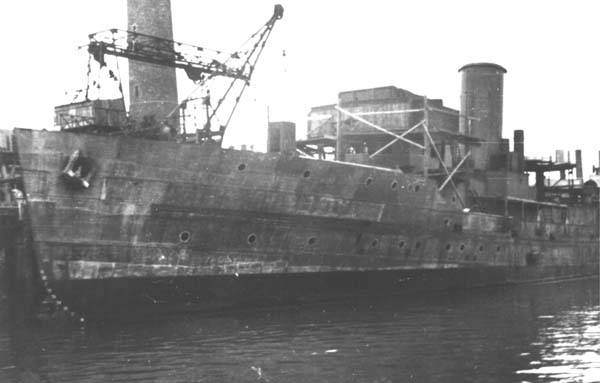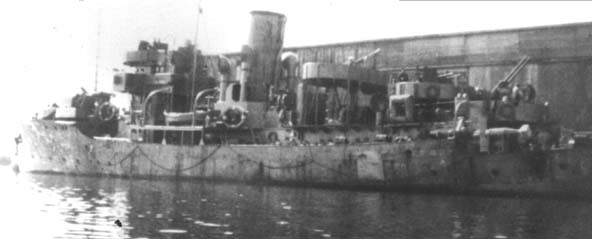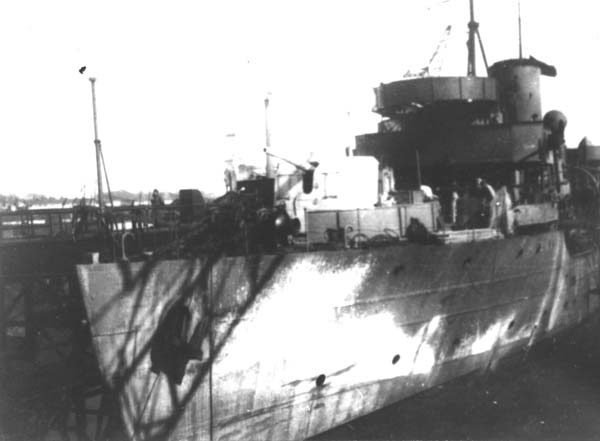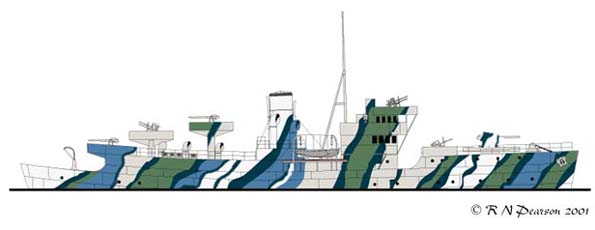Flower Class Corvettes
in Kriegsmarine Service
by Stephan Bock
The French Flowers:
When the German army overran France, they found a number of French Navy vessels either damaged in the ports or being under construction in the shipyards. Four of them were Flower Class corvettes, the French having received the specifications and design from the British. Those ships were being built in the "Chantiers de la Loire" shipyard in St. Nazaire-Penhoet and to be named ARQUEBUSE, HALLEBARDE, SABRE and POIGNARD.
None of the vessels were completed when France fell and all of them were to be built for the German navy, which took over the unfinished ships officially on . ..
Arquebuse 16th of October 1940 as PA 1
Hallebarde 27th of November 1940 as PA 2
Sabre 29th of November 1940 as PA 3
Poignard in 1941 (exact date not known) as PA 4
The designation "PA" stood for "Patroullienboot Ausland" or foreign (captured) patrol craft and was used only for the Flower Class corvettes.
Due to the large amount of work soon to be carried out by the shipyards - both building new ships and repairing damaged ones - and material shortages, it took a long time for the ships to be finished. They were to be taken over by the 15th Vorpostenflottille, stationed in Le Havre and running on channel convoy duty.
The 15th Vorpostenflottille:
The boats of this Flottille were former Whale Catcher / Trawler of German origin, at that time armed with a 3.7cm main gun (ex-anti-tank guns in naval mounts!) at the bow and several 2cm AA guns and machine guns. Some boats began to be equipped with a single 3.7cm AA gun aft. The main drawback of those boats were the fact that their main enemy at night were British MTB and MGB. In order to be able to set up a coordinated return fire, they had to be lightened by flare shells, which the small guns available could not provide. Therefore it was a long standing request to either upgrade the boats armament with 8.8cm guns or provide additional vessels with such guns. A role in which we will see the PAs...
PA 2 was was the first of the class to be put into active service sometime at the beginning of September 1943 with the 15th Vorpostenflottille. The date given at Gröner is incorrect, since the first recorded action of PA 2 was in the night from 26th to 27th of September 1943. PA 2 at that time was on convoy duty, escorting the freighter MALADI together with the minesweeper M82 and M84, VON DER GROEBEN, JUNGINGEN and V1507 of the 15th Vorpostenflottille. The convoy was attacked by MTB of the Dutch navy together with British MGBs. Result of the action: JUNGINGEN damaged and MALADI sunk by torpedos.
PA 3 was the next to be put in active duty on 16th of November 1943. Her first action has not been recorded, her KTB (Kriegstagebuch - war diary) like all the others missing from the archives. One convoy duty that was recorded was that of the blockade runner MÜNSTERLAND (which had made his way from Japan) from Boulogne to Calais on 20th of January 1944. The other escorts were V1506, V1507, V1509, V1511, V1512 of the 15th Vorpostenflottille and R43, R46, R47, R48, R49, R50, R51, R115, R126, R128 of the 4th Räumbootflottille. MÜNSTERLAND was sunk by the radar guided heavy Dover batteries since the ship had given his cargo offboard and wasn't able to manoeuvre fast enough to avoid the hits. All in all Dover batteries fired 46 salvos. (Note: it was standing order at that time to make a zig or zag when the batteries fired. Because of the time it took the shells to reach the target, it could try and get out of his former course - SB).
Recorded as the first joint action of both PA 2 and PA 3 is the escort duty for the tanker RECKUM from Cherbourg to Le Havre on 26th of February 1944. Besides PA 2 and PA 3 the convoy was escorted by V1506, V1507 and V1509. The convoy was attacked by several waves of MTB / MGB and PA 2 and PA 3 are recorded to have fired 344 10.5cm flare shells during the run. Without this support, enabling the escorts to set up an effective return fire on the attackers, the RECKUM wouldn't have made it to Le Havre. One MTB was sunk. The tanker was later sunk by the Dover guns.
PA 1 was the last one to be commissioned to active duty on 15th of April 1944. PA 4 was never put into active duty, it was finally sunk unfinished as a blockship in La Telindiere / Nantes after the invasion.
Lifetime was short for the PAs. Before, and especially following the invasion, the allied air superiority increased steadily and the MGB / MTB attacks increased too, now being supported by destroyers.
PA 2 was sunk during the heavy bombing run of 325 Lancaster bombers on Le Havre at the night of 14th to 15th June 1944, together with six other boats of the flotilla. PA 3 seems to have survived the bombing, but obviously was not deemed worthy of repairs and was therefore decommissioned on 17th of June.
The final fate of PA 1 has not been clarified up to now, it too seems to have survived the bombing. Grˆner states that it was decommissioned at 24th of August 1944. This could mean that it had been damaged and 15th Vorpostenflottille was not be able to make it seaworthy fast enough for the leave.
The 15th Vorpostenflottille left Le Havre at 28th of August 1944 as one of the last German units before it became "fortress Le Havre". The role originally intended to be fulfilled by the Flowers was being taken over by V 716, the former French trawler ALFRED II, which had a 10.5cm main gun and seven AA guns, mostly twins and quads of 2 and 3.7cm. It was nicknamed "Karstadt Dampfer" after the then new German Karstadt-shopping-centres, since the ship had an exceptional high bridge structure of several levels.
Armament and changes in Appearance of the early Flower class design:
The basic appearance of the French Flower class corvettes shows no real differences towards the British short focsle design. Since the armament when taken over by the German navy was much heavier, the structure was modified accordingly. The pic shows PA 4 when taken over by the German navy, showing the basic design at that point.
PA4 is seen under construction. At this point there is nothing to say she is not a typical RN Flower.- RNP
- The ships had a German 10.5cm C/xx naval gun as their main armament,
mounted directly to the deck or in a zareba akin to that fitted to the
V&W class destroyers.
- At the end of the focsle, on each side, a single 2cm AA gun was set
up in a circular bandstand. It can not be said at this point if the guns
mounted were regular 2cm Flak 30 or Oerlikons.
- On top of the fully enclosed bridge a 2cm quad AA gun with gunshield
is mounted in a circular gun tub.
- An oval raised bandstand over the full wide of the deck, build upon
a central pole and containing a centrally mounted AA gun. Guessing from
the photo it could be a 3.7cm AA gun without gunshield.
- A circular bandstand on a central pole, slightly lower then the above
mentioned, aft of the
engine room skylight. It is armed with a 2cm quad AA gun with gun shield.
- A twin 3.7cm AA gun centrally mounted at the very end of the engine
room casing, the half circle bandstand extruding over the end of the engine
room. It seems a gunshield was fitted.
- Two depth charge throwers on each side, mounted on the deck at the end
of the engine room casing
- Minesweeping gear mounted behind the engine room fitting. The main gun
is installed already, but the AA guns are missing. The photo shows the
modified bridge structures fitted.
- Two depth charge throwers on each side, mounted on the deck at the end
of the engine room casing
- Minesweeping gear mounted behind the engine room casing, obviously with
a "Toni" device for acoustic mines.
- The ship carried an external mounted MES (Mineneigenschutz) cable against
magnetic mines.
To allow both the depth charge thrower and the minesweeping gear to work, the gun wale was cut down to deck level, beginning slightly in front of the end of the engine room casing.
The above description is based on the photo of PA 2 below, the only known existing photo showing a German Flower with its armament. The second photo shows PA 2 while outfitting. The main gun is installed already, but the AA guns are missing. The photo shows the modified bridge structure.
PA2 can be seen to have a very heavy anti-aircraft battery consisting of at least one twin 37mm and two quad 20mm Vierlings. She would appear to be in the basic early Flower configuration with the following changes: 4.1" gun mounted directly on deck or in a zareba akin to that fitted to the V&W Class destroyers, new mount for Vierling on top of the bridge. Unknown calibre gun in a raised bandstand immediately aft of the funnel, Vierling in a bandstand and then the 37mm twin on the aft end of the engine room casing. Note that the gunwale on the stern has been cut down to deck level, exposing the minesweeping gear on the stern. - RNP
Detail of the 4.1" gun on PA2's bow. Note the gun tub on top of the bridge for the Vierling. One thought that immediately comes to mind is if she ever ventured out of harbour, what the motion would have been like as the Flowers already had a lively (to put it mildly) motion to them. - RNP
It is relatively safe to assume that the modifications on PA 1 and PA 3 were at least almost identical, since they were carried out at approximately the same time by the same shipyard.
The ships seem to have carried a medium grey paint over all, no different paint can be recognised on the superstructure, nor can a multi-colour pattern be recognised. The ships, despite their short life, look battered, and weld patches over hull damages are quite evident.
The shown photos are the only ones known up to now and are courtesy of Dr. Dieter Jung.
References:
deutschen Kriegsschiffe 1815 - 1945, Bd. 8/2
Erich Groener, Dieter Jung, Martin Maass
Bernhard & Graefe Verlag
ISBN 3-7637-4807-5Seekrieg Im Ärmelkanal
Gunther Naims / Lothar Friedrich
E.S. Mittler & Sohn Verlag
ISBN 3-8132-0810-9
The information provided is based upon the above mentioned references as well as the correspondence I had with Mr. Georg Prager, the lecturer of the book 'Seekrieg im Ärmelkanal". My thanks go to him as well as to Dr. Jung for providing the photos and allowing us to publish them
(C) Stephan Bock 2003.
Conjectural profile of one of the German Flower Class Corvettes PA1-4. The basic image is modified from a small drawing in a book by Dr. Jung, the colours from the Snyder & Short Kriegsmarine chips (just eyeballed to match), and the pattern is based on Sperbrecher 13 (but not identical). The guns and other details await a photo to show exact arrangement.
NOTE: This was originally done for the fun of it and is not intended as a serious reference due to the amount of conjecture used. Additionally, it is now known that the German Flowers only wore overall grey. I had a HD crash and lost most of my Flower illustrations, so this one waits to be redone in the correct colours - RNP October, 2005



